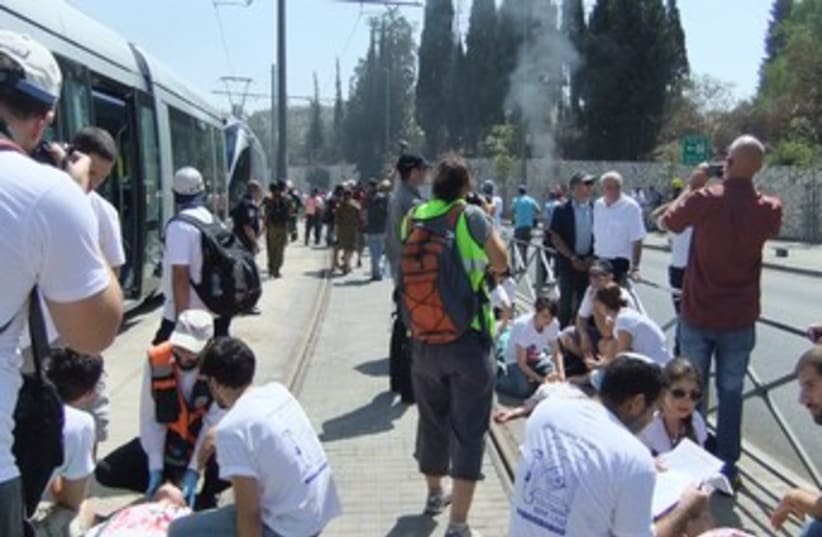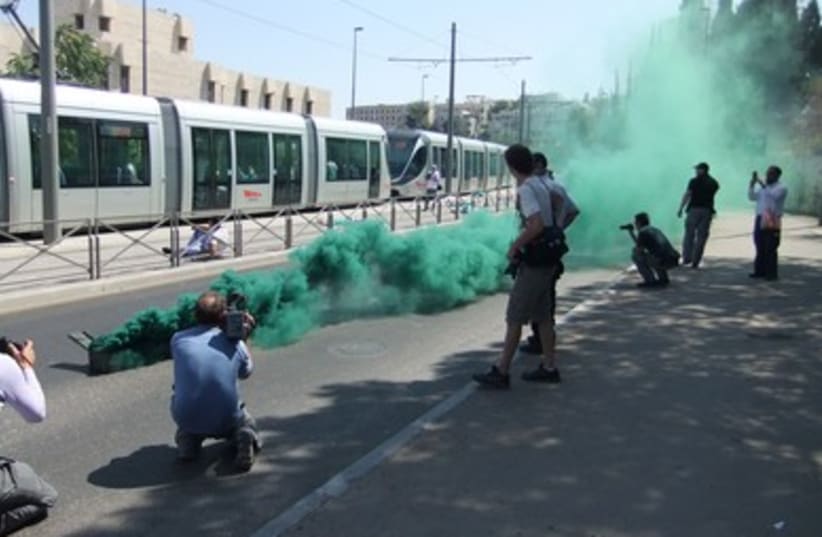
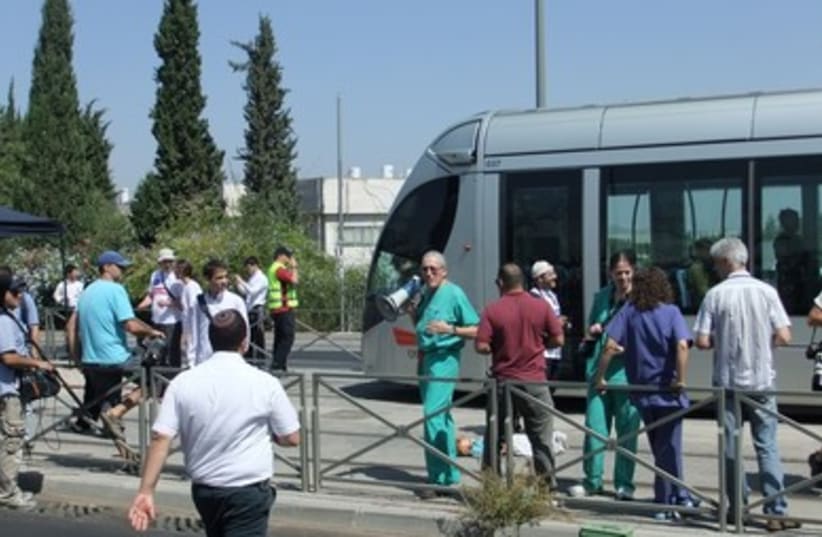

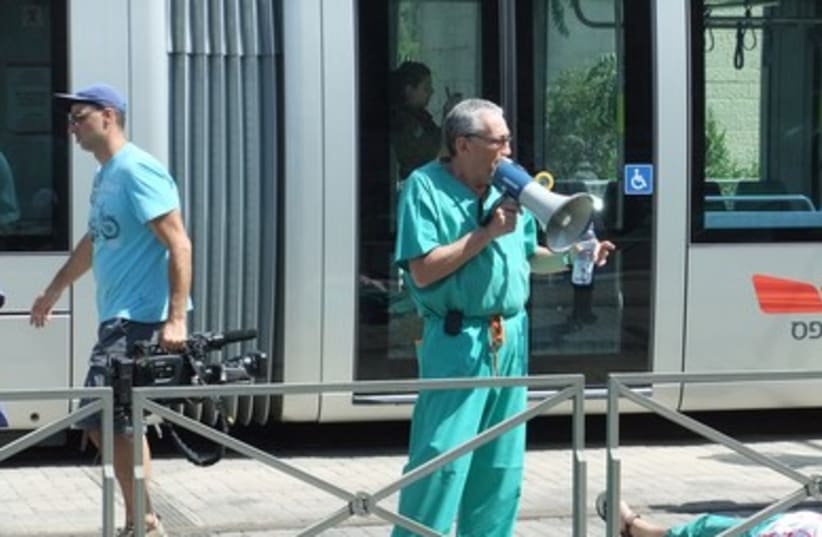
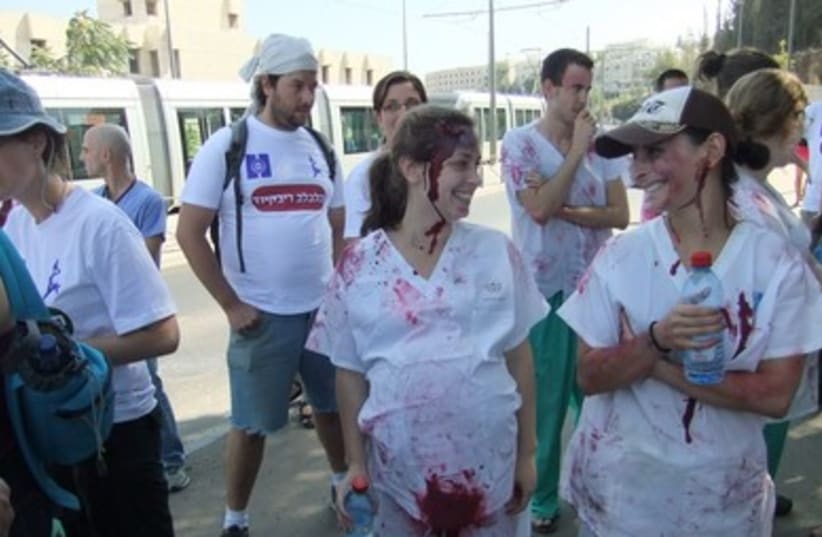

The first comprehensive exercise simulating an attack on the Jerusalem Light Rail proved a success on Wednesday morning, providing training for novice medical staffers and teaching the veterans new lessons on how to improve their performance in an authentic mass catastrophe.The drill was the initiative of the Hebrew University Medical School as a final test for students completing a 10- day trauma course, a week before they complete their six years of formal studies. It was arranged by Prof. Avi Rivkind – chief of general surgery at Hadassah University Medical Center in Ein Kerem, head of its world-acclaimed trauma unit, which he established in 1992, and known as “Dr. Lifesaver” to many Jerusalemites.Last year, the medical school drill took place at Teddy Stadium, but with extensive roadwork going on there to extend the Begin Highway, it was shifted to the light rail’s Mount Herzl station. This marked the new transportation line’s first involvement in such an exercise since it opened to paying passengers almost a year ago.Two women from a school for professional makeup came in – as every year – to lend some authenticity, applying red and purple creams to faces and limbs, creating encrusted “wounds,” spraying red stains on torn clothing and spreading flour on faces to look like they had been hit by dust from explosions.“I have been doing this every year for two decades,” said makeup artist Nava Rogel. “I’m used to it.”About half of the 108 members of this year’s graduating class are women, and many of them were in the trauma course.Medical students acting as doctors, victims, supervisors, photographers and press spokesmen were on hand. Some “wounded” climbed behind fences to lie among bushes, looking as if the blast had thrown them there and waiting until their colleagues found and “treated” them. A disheveled baby doll missing an arm lay outside the train.Metal boxes with green dust that simulated smoke bombs, and burnt tires set in barrels, were set down on Kiryat Hayovel Street at the southern end of Herzl Boulevard, as air-conditioned train cars emptied of regular passengers and filled up with soldiers and medical-student actors instead. Others lay down in the street and tried to look motionless – a difficult task under the hot Jerusalem sun.Traffic was diverted from the key artery to the Kiryat Hayovel neighborhood, causing some annoyance but no alarm to crisis-inured residents.“Moan! Make it sound real!” yelled Rivkind in his green surgical suit, using his megaphone as it began to get noisy.The surprise scenario was that two terrorists had entered the tram, one bearing a suicide bomb that killed him, and the other dying from shrapnel wounds. Medical students, Magen David Adom and United Hatzalah ambulance teams evacuated the train, hauling “wounded” out with their bare hands.“You’re not a porter,” yelled Rivkind when a medical student took a victim too far without first examining and intubating him. “You’re a doctor! He’s dying. Treat him on the spot.”Supervisors with notebooks hurriedly filled in checklists and marked down what the teams were doing. Rivkind’s deputy, Dr. Bala Miklosh, also supervised and watched.A medical student who had pushed a cushion under her red-splashed blouse to become a pregnant terror victim received special attention from the teams, which rushed to evacuate her by MDA ambulance as a helicopter circled above.Public Security Minister Yitzhak Aharonovitch appeared and consulted with Jerusalem Police chief Niso Shaham. Deputy Health Minister Ya’acov Litzman arrived with an entourage of aides and tried to take the scene in.Onlookers from the tangential neighborhood of Bayit Vagan rushed to photograph the scene after they noticed the action. Journalists and passers-by mulled about, even stepping over the “wounded.”“Every terror attack and other mass catastrophe starts this way – as chaos. It is an axiom,” said the Hadassah surgeon after debriefing his students for over three hours at the Ein Kerem hospital. “But you overcome it.”Rivkind, who has probably seen thousands of emergencies, from road accidents to terror attacks, in his long career, told The Jerusalem Post that having ministers and top police officials was unusual.“It was the first light rail drill, and the latest State Comptroller’s Report had criticism of MDA supervision. So everybody came,” he said.He noted that he had shouted at medical students who had rushed into the train without waiting for bomb experts to give the all-clear. And he told the students that ambulance staffers should be moving victims, not the doctors who should be examining and treating them.“The evacuation was fine. But nobody found a ‘victim’ that I sent to lie down among the bushes behind a stone wall. He had to shout, ‘I’m here‚’ before other medical students found him. No one should have gone into the train without the bomb experts giving the OK. This was the major lesson from the September 11 catastrophe in New York,” he said.Still, he conceded, “it’s easy for me to criticize. I have seen so many. I know what to do. At the debriefing, they watched a video made on the scene to learn how to do it better. Everybody did his very best to work together.”He also acknowledged that the police should have kept the civilian onlookers to one side and told the journalists where to go.After the makeshift catastrophe ended, he checked and found that the train was full of trash and had some red stains on the floor and seats. He sent a team of medical students to clean it up, and not long after, the tram made its regular route through the city, with no passengers noting any difference.
